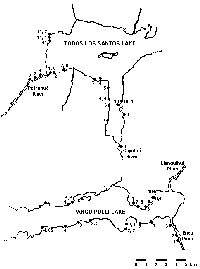 |
Last Update:
Friday November 23, 2018
|
| [Home] |
|
Volume 7 Pages 1 - 43 (February 1992) Citation: Medina Vogel, G. (1992) A New Method for Studying Movements of the Southern River Otter in Chile IUCN Otter Spec. Group Bull. 7: 23 - 24 A New Method for Studying Movements of the Southern River Otter in Chile Gonzalo Medina Vogel Grupo Nutria Chile, Casilla 191, Valdivia Chile
A number of methods have been used to determine the spacing patterns and population density of otters. Because otters are largely nocturnal, direct observation is difficult and provides little information. Techniques such as the use of telemetry or the injection of isotopes were considered inappropriate for a study of the southern river otter Lutra provocax. Instead a simple method was tested, involving the measurement of tracks. During 1990 work was carried out in the Panguipulli lake (39° 43' S, 72° 13' W), Todos los Santos lake (41° 08' S, 72° 12' W) and adjacent rivers (Figure 1). The greater part of the coasts of both lakes is steep and rocky, covered by abundant vegetation. There are few beaches, usually associated with river mouths. Mean annual rainfall, is high (> 3000 mm), occurring throughout the year.
METHODS Tracks and signs (spraint, resting places, dens) were recorded for a year to identify places most frequently used. Because of the absence of mud or snow on the coastal surfaces it is necessary to place sand at landing spots. The technique employed was to scatter a 300 mm wide band of fine, coloured sand (Obercia Industrial, Casilla 12006. Correo 5. Santiago, Chile) at all exits or entrances to the water. When otters crossed the sand their feet become stained and they left coloured tracks on the rocks. Once sand had been placed at all control points they were checked daily. This is important, as it is the only way to obtain an idea of the number of animals in the area. The very high rainfall makes it necessary to place the sand on the driest surfaces. The length and width of every clear track was measured. Tracks could be further distinguished by the shape of the pad and distances between front and hind imprints. After identification, tracks were erased. Control points (dens, resting places) were also checked for spraints. RESULTS Out of 109 occasions that control points were checked, 43 were positive, providing 160 distinct tracks, At 20 of the positive sites spraints were also found, and on only one occasion was a spraint found where there were no tracks. Examples of data obtained from tracks on single field trips are as follows: Panguipulli Lake
Todos los Santos Lake
CONCLUSIONS The technique provides a feasible method of obtaining field data on the movements and density of the southern river otter in an area where normal tracking is impossible. Furthermore, cost of materials is low. The sand used during one year cost US $50. |
| [Copyright © 2006 - 2050 IUCN/SSC OSG] | [Home] | [Contact Us] |
